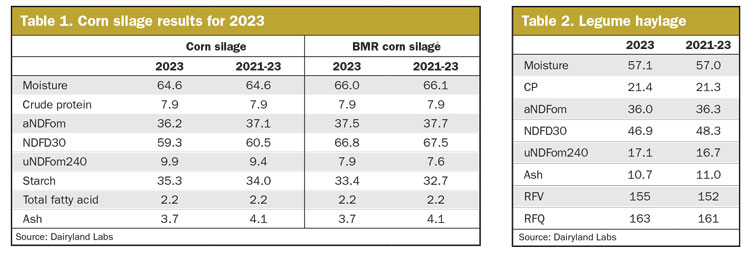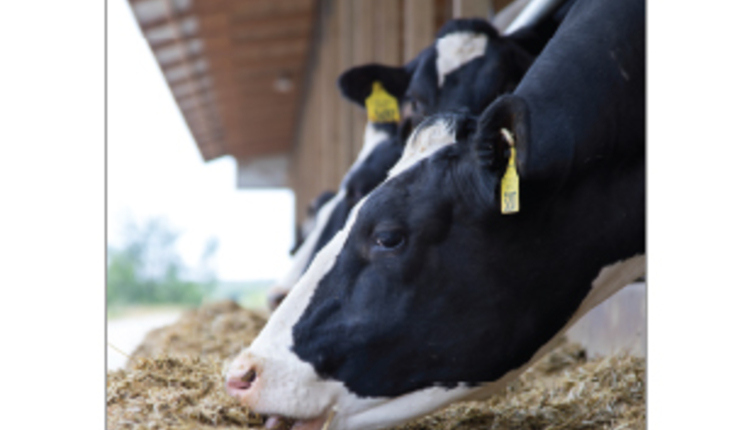The author is a professor emeritus of animal sciences at the University of Illinois, Urbana.

The 2023 forage production season has ended; how did you do?
Forages are the key to improving profitability and reducing feed costs. They provide effective fiber for rumen health, high levels of digestible neutral detergent fiber as energy sources, protein (legumes), sugar (grasses), and starch (corn silage). Forage quality is controlled by dairy farmers when producing and harvesting forages.
Dairy farmers can raise forages at half the market value. For example, alfalfa hay can be produced for $125 or more a ton while market value is $250 or higher.
The focus of this column is for you to compare your forage quality to 2023 average values. Dairyland Labs and Rock River Labs provided summary reports for this article. Review and compare your results to the tables.

Are you above average? Average is the bottom of the top or top of the bottom. In 2024, no room exists for average forages.
Corn silage quality
Corn silage values in Table 1 reflect high-quality feed based on starch content and neutral detergent fiber digestibility (NDFD) values. The NASEM’s Nutrient Requirements of Dairy Cattle, Eighth Revised Edition lists ash content at 3.8% for corn silage with a standard deviation of plus or minus 0.91%. A standard deviation is the variation in submitted samples two thirds below (minus) to two thirds above (plus) the average.
Higher ash content can reflect soil contamination and harvesting methods. Corn silage can have the lowest ash content and variation as it is harvested standing with 6 to 18 inches of stubble. Flood damage to a crop can inflate the ash value.
Low lignin corn silage (BMR or brown mid-rib) reflects the genetic characteristic of lower undigested neutral detergent fiber (uNDF), NDFD, and lower starch.
A look at legumes
Legume (alfalfa) silage nutrient quality is listed in Table 2. Crude protein is important with legumes as a source of nitrogen.
Two forms of protein exist: rumen degraded protein (RDP) and rumen undegraded protein (RUP). The percent of the RDP varies depending on moisture content. Hay is lower while RDP goes up in silage as moisture of the haylage rises. Dairy cows must capture the RDP as microbial protein as a source of amino acids. If the level of RDP in the total ration dry matter is higher than 10%, excessive ammonia is transfered to the blood, converted by the liver to blood urea nitrogen, and recycled or excreted by the kidney in the urine or milk as milk urea nitrogen (MUN).
A useful number is relative forage quality (RFQ) based on NDFD and dry matter intake equations. A value over 150 is recommended for lactating cows. Each point in RFQ can be valued at $1.20 when selling hay. For example, hay at 180 RFQ times $1.20 equals $216 a ton.
Ash content in legume silage is higher than corn silage at 10.6% with a standard deviation of 1.73%. Ash can cause fermentation risk and impact cow health. Ash also takes up space in the ration, reducing nutrient content.
Small grain forages
With the expanding role of winter cover crops, small grain acreage is increasing. Winter triticale, rye, and wheat are planted after corn silage removal, which reduces moisture runoff. Soil erosion is reduced, and it offers an early spring forage crop if needed. Quality of small grain forage varies greatly.
Spring planting of oats as a nurse crop is popular. Barley and wheat can also be planted in the spring. Wheat provides a choice to harvest for grain (if wheat prices are favorable) plus wheat straw or harvest as forage if needed. Harvesting in the boot stage can be similar to corn silage in NDFD percent (called “poor person” corn silage with limited starch, but sugar levels can be higher). Harvesting in the dough stage replaces straw in dry cow and old heifer rations with twice the dry matter tonnage per acre compared to boot stage.
The level of ash in triticale is 10.1%, with the largest standard deviation of 2.24% due to harvesting conditions.
Dairy farmers can kill the cover crop prior to planting corn for silage or soybeans with chemicals or harvest the standing crop in the dough stage after killing it with chemicals after seven to 10 days. Illinois research indicates supplemental nitrogen may be needed after planting corn as the nitrogen can be less available and used by the cover crop.
The fermentation profile
Other valuable tests offered by commercial labs include pH (measure of acidity) and volatile fatty acid levels. There are guidelines for haylage (legumes, grasses, and small grain), corn silage, and high moisture corn. The fermentation analysis reflects optimal moisture content, packing, covering, and inoculant application resulting in a stable feed. This test reflects on-farm success in storing and fermenting wet forages and grain.
Kernel processing variation
Corn silage kernel processing scores are widely varied. A graph of kernel processing scores would show improvement year to year, but the lack of a distinct peak or bell shaped curve reflects the wide range in tested corn silage values.
Western states scores are higher than Midwest corn silage value. Wisconsin experts recommend a kernel processing score over 70, while top managers are achieving 75 to more than 80. Processing scores are important as dry matter rises over 33%. Kernels are higher in starch and more mature. Dairy managers chopping corn silage below 32% dry matter may not need processing as kernels are softer, but starch yields are lowered, requiring more supplemental corn or barley grain.
The take-home messages
In 2024, the recommendation is to test, test, and test as dairy farmers can expect changing forage quality due to drought, low corn pollination, flood, and variation between crops and within crops. Measure on-farm inventories now to determine if you have adequate forage resources so you can purchase hay, other forages, or by-product feeds to stretch your inventory.
Cover crops provide benefits to your land (less soil erosion), environment (loss of nutrients such as nitrogen and phosphorous), and flexibility (early forage crop or green manure in the spring). They are a win-win for dairy farmers and the environment.
Every 1% rise in corn silage dry matter can result in an increase of one percentage point in starch as the crop matures. Keep this in mind.
Finally, do you have the optimal balance for forages in your feeding program? In Illinois, two-thirds of corn silage and one-third of legume/grass/small grain forage crops of the forage dry matter are optimal in balancing RDP levels and reducing the amount of corn or barley needed. The result is lower feed costs per pound of dry matter. Growing conditions and soil types can impact your forage considerations and decisions.





